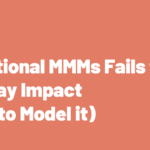Not all MMMs are created equal. A good MMM can uncover causal relationships, provide actionable insights, and transform your marketing efficiency. But a bad one can waste millions in misallocated spend and leave your team frustrated and confused.
So, how do you tell the difference? What separates a robust, reliable MMM from one that does more harm than good?
This article breaks down the five essential features that make a marketing mix model great. Let’s dive in.
1. Accurate Causal Inference
The cornerstone of a good MMM is its ability to identify causal relationships. Nothing else really matters. Can your MMM give you accurate information on what’s incremental or not? If you don’t have that, none of the other features matter at all. But if you do have that, all of the other features –a nice UX and UI, etc.– become just a “nice to have.”
It should go beyond mere correlations to determine what marketing actions are actually driving business outcomes.
For example, a model might observe that TV spend correlates with revenue spikes, but is TV really driving those spikes, or is it coinciding with seasonal demand? A good MMM isolates the impact of TV spend, separating it from other factors like seasonality, promotions, or organic demand trends.
If your MMM can’t answer questions like “What would happen if we stopped spending on Channel X?” with confidence, then it’s not capturing causal relationships –and that makes it unreliable.
2. Transparency
Every MMM is built on assumptions –about how channels work, how sales are driven, and how different variables interact. A good MMM doesn’t hide these assumptions; it makes them explicit.
Transparency starts with priors, hyperparameters, and data transformations. For example, if your model assumes that paid search converts instantly while TV takes weeks, those assumptions need to be visible. This makes sure that everyone involved –from data scientists to marketers– can understand how the model operates and why it produces the results it does.
When assumptions are hidden or unclear, your model will be untrustworthy and it will become impossible to identify and correct flaws. The “rules of the game” need to be out in the open.
3. Robust Validation
Validation separates a good MMM from a bad one. It’s not enough for a model to produce results that “look right” –it needs to prove its reliability through rigorous testing.
A good MMM passes out-of-sample forecast accuracy tests, meaning it can predict what will happen when marketing budgets change. For example, can it accurately forecast the impact of pulling $1M from YouTube or launching a major TV campaign? If not, again, you can’t trust it.
Another key validation step is making it easy for it to be validated through experiments. The closer the MMM aligns with experimental data, the more reliable its outputs will be.
So a good MMM has the tools to help you do that validation.
4. Stability and Consistency
A good MMM produces stable results even when inputs or assumptions shift slightly. If a model’s outputs swing wildly with small changes to data or configuration, it’s a red flag that it isn’t robust enough to trust.
For example, if it says that TV is your most incremental channel this month but drops it to the least incremental next month without clear justification, something is wrong.
Consistency makes sure that the model isn’t overly sensitive to noise or random fluctuations – and it allows you to have confidence in using it for your long-term planning and decision-making.
5. Actionable Insights
An MMM is only as good as its ability to help you make better marketing decisions. It can’t stop at diagnosis, it needs to follow through into scenario planning and optimization.
For example, your MMM should answer questions like:
- What happens if we allocate an additional $500K to paid social?
- How should we rebalance our budget across channels to maximize incremental revenue?
And to add to that, it should self-serve, as in the insights should be accessible enough that marketing teams can forecast outcomes, make recommendations, and align with finance –all without requiring constant vendor support.
TL;DR – What Makes a Good Marketing Mix Model?
- Accurate causal inference – The MMM must reflect the true cause-and-effect relationships between marketing actions and business results.
- Transparency – All assumptions, priors, and hyperparameters must be explicit and easy to understand.
- Robust validation – The model must pass tests like out-of-sample forecast accuracy and align with experimental results to ensure reliability.
- Stability and consistency – The MMM should produce stable, reliable results across different datasets and scenarios.
- Actionable insights – It should enable scenario planning, forecasting, and help marketers make data-driven decisions.



